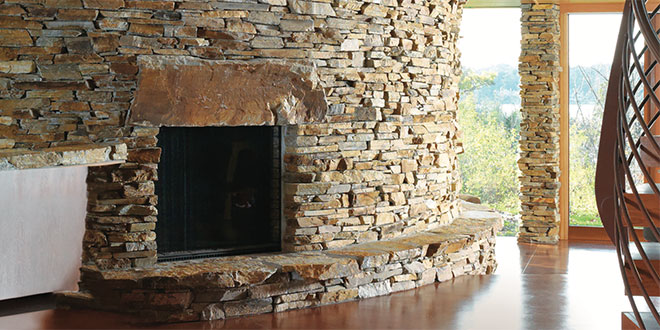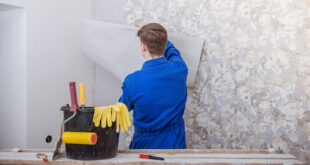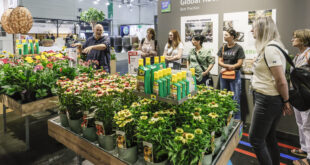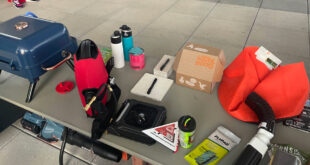It’s the small touches that can make a house a home. Many homeowners see their house as a sanctuary and a symbol of their tastes and priorities. Do they prize game day celebrations in a renovated basement? Or do they prioritize outdoor living space with friends and family? Each person’s preference is important, and versatile surfaces such as concrete are key to helping these homeowners make their homes unique. With modern technologies, there are few materials as versatile for home and commercial projects as concrete. Modern dyes, colorants and sealants have made concrete part of the design conversation, elevating it from its previous place as just a building component. Concrete stains can give a basement floor the look of well-worn leather furniture, while outdoor spaces can be outfitted with concrete walls that simulate fine stone.
Hardware Retailing spoke to Tim Margroff, general manager of Marcon Building Supply in Markleysburg, Pennsylvania, who oversees a retail operation that manufactures its own decorative concrete pavers and retaining wall blocks. It offers materials for DIYers to apply their own stains, coatings and sealants to concrete surfaces in their homes.
For a professional trade perspective, Hardware Retailing spoke to Mike Price, CEO of Bay Area Concretes in San Francisco, and Shawn Wardall, owner of Specialized Construction Services in Waterloo, Wisconsin.
Bay Area Concretes has worked on concrete design projects for tech giants like Facebook and Google, among others. Wardall travels across the U.S. as an independent concrete designer while also teaching classes related to decorative concrete.
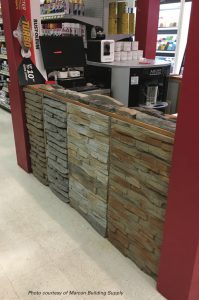
Solid Possibilities
Concrete can be seen as a utilitarian product, made for function rather than fashion. Traditional surfaces like walkways, driveways or flooring, can benefit from decorative dyes and stains, which can make any space more vibrant.
For Margroff, the first job of any retailer hoping to delve into decorative concrete is to open the eyes of customers to the possibilities offered by these kinds of products. Marcon Building Supply accomplishes this by showing displays, both on its salesfloor and on its exterior property, that exemplify how concrete can be manipulated and colored to give different effects.
“Our displays show not only how color can be involved, but how the customer can customize their projects. A color can have a different look based on a smooth cut versus a rough face that is made to look more like stone,” Margroff says. “What we’ve found is that customers often need the idea presented to them in person to see how concrete can be made to look like a variety of materials. Just describing the finished look won’t get the idea across.”
The concrete displays at Marcon Building Supply often start a more in-depth conversation with customers about the other options Marcon Building Supply has available. These include prestained concrete pavers in a variety of colors as well as DIY sealants that can add a bit of gloss to concrete.
Marcon Building Supply’s ability to manufacture landscaping blocks means it offers convenient, ready-to-install pavers while also keeping options open for consumers looking for their own custom colors. For these customers, dyes and stains can be added to the surface of plain blocks which are then sealed to maintain the color and protect it from damage that will reveal the gray concrete underneath.
Blocks manufactured with premixed dyes will maintain that color throughout the block, but stains require maintenance over time to sustain a stain’s look. While this does add a task for homeowners, Wardall says the process of maintaining a sealant coating on concrete is a task most DIYers can do themselves.
“We like being able to offer options for concrete manufactured with color throughout as well as stains and sealants that can be applied later,” Margroff says. “Then a customer can get the color exactly as they want it, and we can be there to make sure they know the proper steps for application.”
Some of those steps include the need to strip concrete of previously applied sealant before a new stain is applied. Wardall cautions professionals and homeowners alike that most staining and sealing projects go wrong because the surface has not been prepared in the proper manner. Retailers should be ready with tips about not just the application of stains and sealants, but what steps must be taken prior to applying these coatings.
Manufacturers are often the best sources for this knowledge, especially given the unique formulations of different stains and dyes.
While Marcon Building Supply manufactures its own concrete landscaping blocks and decorative pieces, not all retailers will have access to the equipment necessary to do that. For retailers who want to offer concrete as an option for customers looking to create outdoor spaces like garden beds or stain a bare concrete floor in their home, Margroff believes salesfloor displays are still paramount.
Look for a supplier of decorative concrete blocks and create options for a salesfloor display, Margroff says. Stain these items yourself to show what different stains and sealants can do with plain concrete and have those items available when customers ask how a display was created. The customers might even be surprised to learn that a display was made with concrete in the first place.
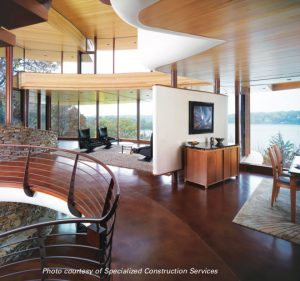
Going for Depth
For homeowners looking to take on a project themselves, there are a variety of options. The most common stains are either acid-based or water-based.
Wardall says the different color ranges that can be achieved with either type of stain means that there is a finish that will appeal to nearly any customer. In his previous work, water-based stains are more environmentally friendly but can be more difficult to apply properly.
To counteract some of these challenges for customers who are not fully versed in the concrete staining profession, Wardall suggests retailers become confident with a few stains or dyes they have seen success with in past projects. Retailers can combine their trusted products with water-based sealants that are more easily applied, add to the overall design based on their glossiness and are more easily maintained than more intensive stain applications.
“When I’m working on a project that I know will fall on the homeowner to maintain, I don’t want to set them up for failure,” Wardall says. “I’m seeing a lot of customers who want simpler looks, sometimes even just bare concrete with a glossy sealant. These are cost-effective options that, if maintained properly, will serve customers well into the future.”
If customers want to further experiment with stains and effects, Wardall suggests the combination of colors to give a layered look. This adds a bit of labor to the process, but it allows for a more intense look without requiring a homeowner to possess strong design skills. The stains will take on different hues based on the condition of each area of concrete, often combining to form designs that resemble natural wood, leather and treated wood.
Another measure retailers can take when streamlining DIY projects is diving fully into the application instructions for individual brands and manufacturers in the market. In Wardall’s experience, the proper application of stains and sealants can vary widely across manufacturers, and methods that work for one could lead to poor results from another.
“This is not a project type that favors mixing and matching products,” Wardall says. “A retailer should have enough training from the vendor to give specific instructions on how their product offerings should be treated. Informing their customers of this fact can keep a project from coming up short of a customer’s expectations.”
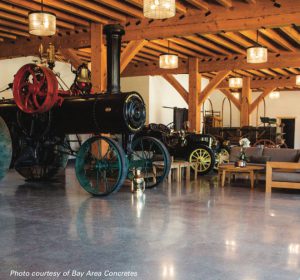
Adding Some Polish
For Bay Area Concretes, the trend in both residential and commercial work has been toward environmentally friendly options. This includes nonreactive dyes that do not have the harsh chemical smells of some older stains and dyes and can create durable, decorative concrete floors.
“Concrete stains and sealants first started gaining popularity in the 1990s and 2000s in residential markets. They remain popular, and the options for homeowners to customize their concrete surfaces are only getting more diverse,” Price says. “We’ve seen a shift, especially in commercial projects, to more polished looks with maybe a bit of color added. It adds durability and refinement.”
Polished concrete has been a major trend for Wardall’s projects as well. Polished concrete, which has been ground down with fine amounts of diamond grit, offers an elegant and durable finish that works in high-traffic areas like building lobbies just as easily as fashionable residential floors.
To offer these kinds of options for contractors and professionals working with concrete, retailers can offer equipment for rent. Price uses both walk-behind and riding polishing machines that refine a floor and cover an entire surface in a short amount of time.
Other rental options include stamps, which Marcon Building Supply offers to tradespeople with access to lifting equipment. These stamps can create effects to mimic stone or other designs when used on freshly poured concrete. Margroff says his brother’s new pool is an example of how dyes and concrete stamps can be mixed to provide unique results in outdoor spaces.
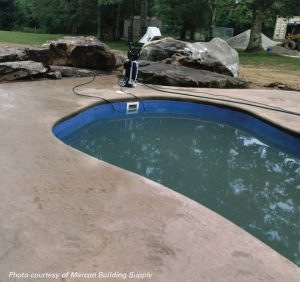
“When the stamp is used around the pool, we can get the right texture for the surface. Then you come back with a sealantthat gives you a bit of variety in the color. These two applications make for a standout display that many customers haven’t seen before, and they don’t require expensive materials to pull off,” Margroff says.
Price suggests another display option for concrete is a retailer’s store itself. By taking a display a step further, such as turning a section of the store into an outdoor display area complete with its own stained floor area, a retailer can show how customers can design their own homes.
Making sure the concrete at their store’s location looks its best is also a crucial selling point, Price says.
“The cost of scale for high-quality concrete displays is getting lower all the time,” Price says. “A well-treated salesfloor shows a customer that their own concrete flooring doesn’t have to be drab.”
 Hardware Retailing The Industry's Source for Insights and Information
Hardware Retailing The Industry's Source for Insights and Information


